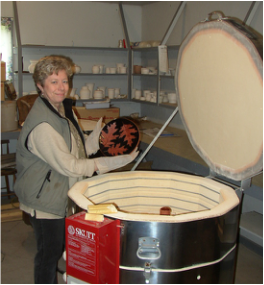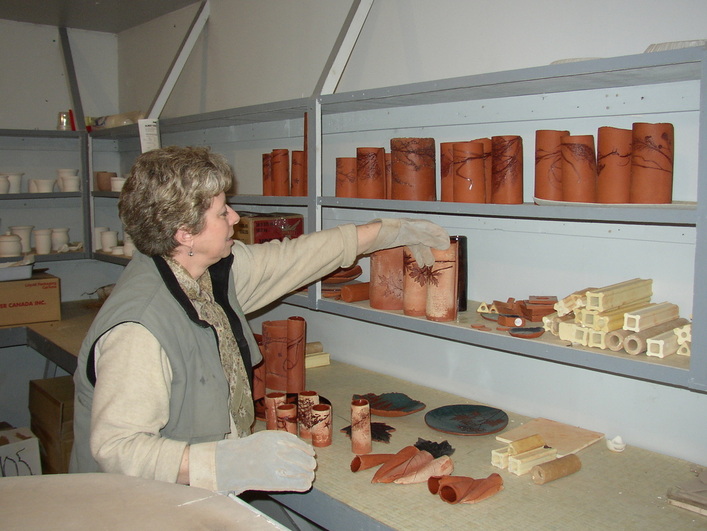 Judy Tait unloading the kiln.
Judy Tait unloading the kiln.  Judy Tait
Judy Tait In 1699, Acadians settled in the area and began to build dykes along the tributaries of the Petitcodiac. The dykes kept the saltwater out, creating fertile farmland and (incidentally) providing ideal conditions to protect the estuarine clay from saltwater.
The clay comes from near the dykelands of the Petitcodiac but the specific source is a secret. When I ask David where he got the clay, he says (while laughing), “If I tell you, I would have to kill you.” The New Brunswick Geological Survey recorded the deposit in the mid-1800s, yet the Taits believe that before then the Acadians and Mi’kmaq likely used the clay in making, for example, bowls and bake ovens.
The search for clay
The Taits need clay that is pliable and plastic yet strong enough to withstand being fired in a kiln at 2000F. In their search for the ideal clay, they found a lot of clay, ranging in colour from grey to red to the bright colour of an orange. They shaped and fired samples. Some exploded in the kiln, others melted, but eventually the Taits found one that worked.
“It was a real hardship getting it at first,” Judy says. “We collected it all using buckets, and wet clay is very heavy. But we found a source of clay that fired beautifully. And then we thought we should talk to the landowner to ask permission to use it.” Fortunately, the landowners were not just willing to allow the Taits to take some clay, but own heavy machinery and now dig up and deliver the clay, tons of it at a time.
As an art student, Judy had studied pottery years ago but chose instead to specialize in fabric design. She taught surface (fabric) design in the New Brunswick College of Craft and Design in Fredericton for years. She is still involved in silk screen work with her other business, Samphire Casuals. David taught sheet metal work at the community college in Moncton for twenty years before retiring and becoming responsible for preparing the clay for Judy’s pottery.
“Once Judy started making pottery,” David remembers, “I started hearing, ‘David, I need more clay.’” Judy adds, “And that’s still going on,” and they both laugh.
Processing the clay
The process of going from wet clay straight from the ground to a workable pottery medium is complicated and time-consuming. Through ingenuity and patience, David developed a system that works for them, and Judy uses her creativity to transform the clay into artwork.
The first step is drying the clay. Initially, the Taits dried the clay outside in the sun but the process was too slow and didn’t work in the winter, so David built a drying chamber made up of screened shelves where the clay is essentially baked at low heat. The dry clay is then pulverized into powder in a machine that David built; it’s something akin to a small cement mixer. The clay is then sifted through screens to remove foreign material, such as dried plant material and sand. When more Judy needs more clay, David adds water to the powdered clay, which transforms it from a greyish-white powder to red clay.
The damp clay needs to be ‘wedged,’ which means taking the air out of the clay. Air in the clay can make the clay more difficult to work, and (more dramatically) can cause the pottery to explode in the kiln. David uses a pugmill, a piece of equipment with an auger to push the clay and a vacuum pump to suck the air out. He then rolls the clay into thin sheets by using a mechanical press.
Making pottery
Judy now takes over. She shapes the flat slabs of clay into vases, wine coolers, bowls, plates and more. She presses flowers, leaves, seaweed, shells and/or grasses into the damp clay, which leaves intricate imprints. After she works the clay, the pottery is left to dry and its colour changes from red to white. It is then fired in the kiln, and acquires a light brick-red colour.
After the first firing (the bisque firing), Judy coats the interior of most of the pieces with a clear glaze to make them watertight. For some, she also applies a lightly-tinted glaze on the exterior. The glazed pottery is fired again at 2000F for eight hours. It takes another eight hours to cool down. The colour changes to a deep terracotta colour as the iron oxidizes in the heat.
Facing the challenges
The Albert County Clay Company has been in business for six years. Finding the appropriate clay was only one of the many challenges the Taits have faced. Judy recalls a point where they had to make a commitment to expand and take the business more seriously. The challenging decision was to buy a pugmill, an expensive device used to take the air out of the clay. Until this point, Judy was kneading the clay by hand but that proved to be unfeasible given the volume of clay she was dealing with. After deciding to invest in the equipment, Judy was so excited that they held a ‘pugmill party’. Most of their friends had no idea what a pugmill was, but apparently the party was great.
Another pivotal decision came when the business outgrew the house. At the time, they were working in the old Curryville schoolhouse, a building they had also lived in until they built a house across the road. Between the schoolhouse and their own house, lay the abandoned Curryville Community Hall. The community hall is now used as the workshop, the schoolhouse is the gallery and the house across the road is for living and doing the business side of things.
Marketing takes up a lot of their time. “It’s hard being an artisan and a business person,” Judy says. “But on the other hand, it forces you to use both sides of your brain…and there’s always something to grapple with.” The pottery is now sold to craft stores across the Maritimes, including the shops on the Marine Atlantic ferries, and in the New Brunswick Museum’s gift shop. It is also used for corporate gifts. For example, a company that sells corporate gifts to the federal government buys pieces decorated with maple leaves to give to foreign visitors.
Judy loves doing the pottery and enjoys the connection between the land and the art. “As a society, we’re always going away from that…losing the connection to local resources,” she says. Her clay isn’t like the standard commercial pottery clay. She finds that its limitations have forced her to become more creative, to think of designs that work with, not against, the clay. On the other hand, she tried using commercial clay recently and found that it didn’t hold up to the designs she now uses with the local clay.
David adds that he likes the connection with local history. In the 1800s, the Albert Brick, Lime and Cement Company operated just up the road from them. He points out that “just about any clay can be used for brick.”
David jokes that the pottery has “become a compulsion for Judy. We’ll be driving down the road and she’ll say ‘stop, there could be clay there’ or ‘let’s get some of those leaves.’”
If it’s a compulsion, it seems to be a healthy one. Judy describes her work as “exciting and rewarding in many ways.” She appreciates how pottery involves both her mind and her body at the same time.
In the Albert County Clay Company, Judy and David Tait have found a way not just to merge their skills, but also their passion for art, nature and their local environment.
How to prepare your own clay (the slow way)*
1. Spread in a thin layer and allow to dry in the sun.
2. Pound the clay with a baseball bat or heavy roll pin until it’s as fine as sand.
3. Sift through a large kitchen strainer or window screen.
4. Put the clay powder in water. Use ½ to ¾ as much clay powder as water. Let the clay absorb some of the water before stirring to prevent lumps. Then stir until thoroughly mixed.
5. Let the wet mixture settle for half a day and then pour off the excess water.
6. Store the clay in plastic bag and let age for three weeks before using.
7. ‘Wedge’ the clay to remove excess air by kneading it on a sheet of unfinished plywood, a plaster surface, or large piece of unfinished wood.
Now you’re ready to make pottery, though there are no guarantees that the pieces will withstand the heat of the kiln.
*Based on instructions from The Potter’s Primer by Eleanor Chroman, 1974, Hawthorn Press.
For information on the Albert County Clay Company, see http://albertcountyclayco.com/. To visit the studio, call first at 506-734-2851.
Janet Wallace likes to create food from the clay in her soil, and has just started to learn how to make pottery from commercial clay. She is also a freelance writer and editor.
Article by Janet Wallace, published in Rural Delivery, 2006.
 RSS Feed
RSS Feed